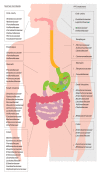Proton pump inhibitors and dysbiosis: Current knowledge and aspects to be clarified
- PMID: 31235994
- PMCID: PMC6580352
- DOI: 10.3748/wjg.v25.i22.2706
Proton pump inhibitors and dysbiosis: Current knowledge and aspects to be clarified
Abstract
Proton pump inhibitors (PPIs) are common medications within the practice of gastroenterology. These drugs, which act through the irreversible inhibition of the hydrogen/potassium pump (H+/K+-ATPase pump) in the gastric parietal cells, are used in the treatment of several acid-related disorders. PPIs are generally well tolerated but, through the long-term reduction of gastric acid secretion, can increase the risk of an imbalance in gut microbiota composition (i.e., dysbiosis). The gut microbiota is a complex ecosystem in which microbes coexist and interact with the human host. Indeed, the resident gut bacteria are needed for multiple vital functions, such as nutrient and drug metabolism, the production of energy, defense against pathogens, the modulation of the immune system and support of the integrity of the gut mucosal barrier. The bacteria are collected in communities that vary in density and composition within each segment of the gastrointestinal (GI) tract. Therefore, every change in the gut ecosystem has been connected to an increased susceptibility or exacerbation of various GI disorders. The aim of this review is to summarize the recently available data on PPI-related microbiota alterations in each segment of the GI tract and to analyze the possible involvement of PPIs in the pathogenesis of several specific GI diseases.
Keywords: Cancer; Dysbiosis; Gastrointestinal infections; Gastrointestinal tract; Gut microbiota; Helicobacter pylori; Hypochloridria; Proton pump inhibitors.
Conflict of interest statement
Conflict-of-interest statement: No potential conflicts of interest to report.
Figures


References
-
- Scarpignato C, Pelosini I, Di Mario F. Acid suppression therapy: Where do we go from here? Dig Dis. 2006;24:11–46. - PubMed
-
- Bardou M, Toubouti Y, Benhaberou-Brun D, Rahme E, Barkun AN. Meta-analysis: Proton-pump inhibition in high-risk patients with acute peptic ulcer bleeding. Aliment Pharmacol Ther. 2005;21:677–686. - PubMed
-
- DeVault KR, Castell DO American College of Gastroenterology. Updated guidelines for the diagnosis and treatment of gastroesophageal reflux disease. Am J Gastroenterol. 2005;100:190–200. - PubMed
-
- Sharma VK, Leontiadis GI, Howden CW. Meta-analysis of randomized controlled trials comparing standard clinical doses of omeprazole and lansoprazole in erosive oesophagitis. Aliment Pharmacol Ther. 2001;15:227–231. - PubMed
Publication types
MeSH terms
Substances
LinkOut - more resources
Full Text Sources

